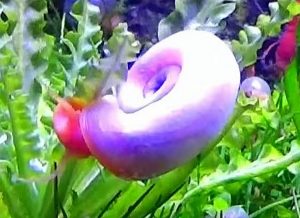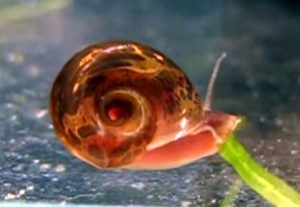Ramshorn Snails (Planorbids) also known by tropical fish keeping enthusiasts as Ram’s Horn Snails, Wheel Snails, Ear Snails, Red Ramshorns, and Brown Ramshorn are in a family of air breathing freshwater snails that have planispiral (coiled flat) shells.
Although most aquarium Ramshorn Snail species are in the Planorbidae family, one species, the Giant Ramshorn Snail (Marisa cornuarietis) which is widespread throughout northern South America is actually an Apple Snail in the family Ampullaridae.
Ramshorn Snails are slow roaming snails that live in ponds, rivers, lakes, and slow moving streams
Ramshorn Snails have a rather small foot and head, with relatively long tentacles with the eye spots at the base of the tentacles. All Ramshorn species within the Planorbidae family have sinistral shells. The shell colors range from translucent through various shades of brown to a dark, nearly black color.
Like all aquatic air breathing snails, they have no operculum. Their shell opening is slanted downward to the right and folds of skin often protrude from the left side of the opening.
Ramshorn Snails are scavengers that are frequently introduced into freshwater aquariums as egg bundles on live plants and although they are considered a nuisance by many aquarists, they provide the useful function of eating algae as well as cleaning up decaying plant and animal matter in the aquarium. Although they will eat delicate plants, they prefer dead or decaying plants, algae, uneaten fish food, and any unnoticed dead fish in the tank.
Ramshorn Snails can be housed in any size aquarium with any non aggressive fish species such as guppies, neons, danios, white clouds, and cory catfish and unless you use them for food, they should not be housed with loaches, puffer fish, gouramis, or angel fish.
They prefer slow moving water but do not do well in a poorly aerated tank and will climb out of the water if the oxygen levels are too low. Ramshorn Snails do best in hard water conditions for healthy shell growth and like other aquatic pulmonate gastropod mollusks cannot tolerate copper in even minute amounts.
Ramshorn Snails are prolific breeders and can quickly overpopulate an aquarium. A Ramshorn Snail will normally start reproducing within 4 weeks after being born. They are hermaphrodites, which means they carry both male and female sex cells and change between sexes when mating however, they cannot mate alone and need another snail to exchange cells with to successfully reproduce. They are also able to auto fertilize themselves.
Ramshorn Snails will go up to the surface of the aquarium to lay their egg clusters just under the surface of the water. The egg clusters are protected by a tough jelly like substance and depending on the temperature of the water, will usually hatch out between 12 to 30 days. The young need no special attention and will take care of themselves.
If there is an overabundance of food in the aquarium, Ramshorn Snails will continue to reproduce unchecked, and will quickly overpopulate the tank. When this occurs, it may be necessary to introduce another snail eating species (Assassin Snail) or fish (Clown Loach) to the tank to reduce the population.
Placing a piece of fish or a wilted carrot in the tank at dusk will attract the snails to the “bait” where they can be easily removed from the tank.
Ramshorn Snails are available from many pet shops under a variety of names when they are 1/2″ to 1″ in size.
Minimum Tank Size: 2 gallons
Care Level: Easy
Temperament: Peaceful
Water Conditions: 64-86° F, gH 8-18, pH 7.0-8.0
Max. Size: 1/2″-2″
Color Form: Red, brown, black
Diet: Omnivore
Compatibility: Excellent community tank cleaner
Origin: Americas
Family: Planorbidae
Lifespan: 1-2 years
Aquarist Experience Level: Beginner




One Response to “Ramshorn Snail (Planorbidae)”
Trackbacks/Pingbacks
[…] helena are fond of eating Malaysian Trumpet Snails, Ramshorn Snails, and Pond Snails. When snail populations in the tank become depleted, they require additional […]